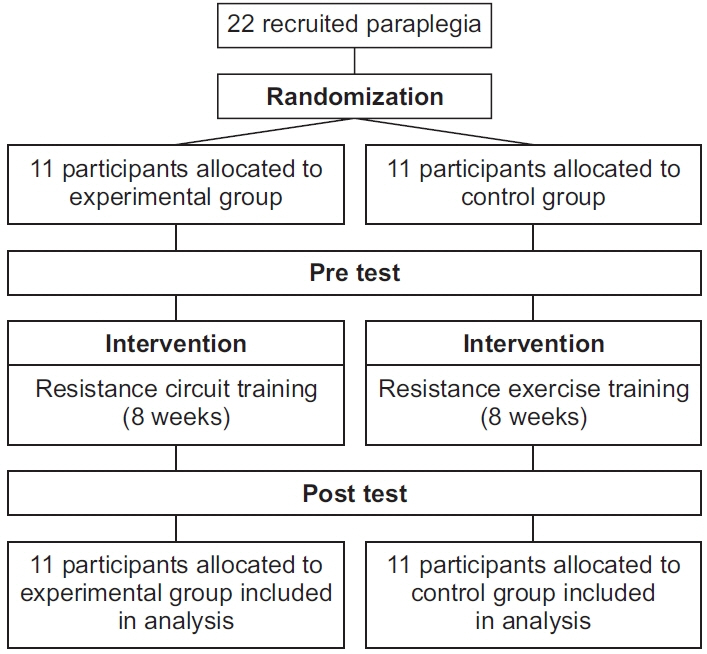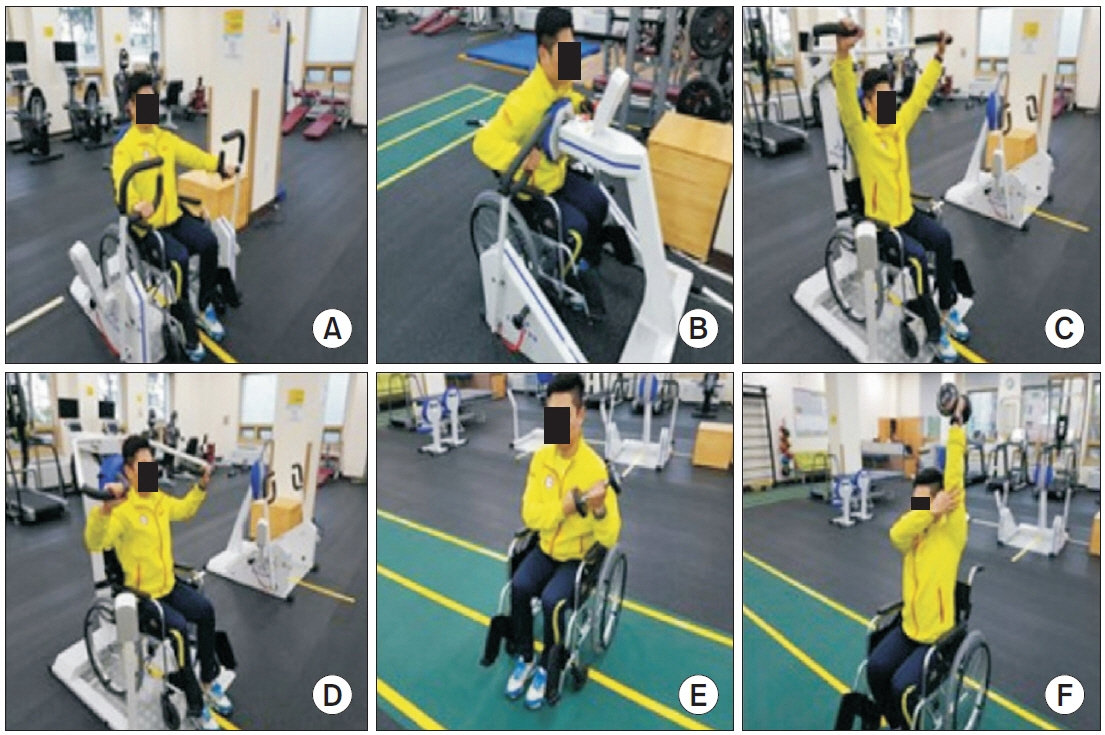Ann Rehabil Med.
2022 Apr;46(2):87-96. 10.5535/arm.22012.
Effects of Resistance Circuit Training on Health-Related Physical Fitness in People With Paraplegia: A Pilot Randomized Controlled Trial
- Affiliations
-
- 1Department of Physical Medicine and Rehabilitation, National Rehabilitation Center, Seoul, Korea
- 2Fitness & Rehabilitation Exercise, National Rehabilitation Center, Seoul, Korea
- 3Department of Physical Education, Konkuk University, Seoul, Korea
- 4Department of Healthcare and Public Health Research, National Rehabilitation Research Institute, National Rehabilitation Center, Seoul, Korea
- KMID: 2529509
- DOI: http://doi.org/10.5535/arm.22012
Abstract
Objective
To evaluate the efficacy and safety of 8 weeks of resistance circuit training in people with paraplegia due to spinal cord injury.
Methods
Participants were randomized into experimental and control groups. Although the intensity and sequence of movements of the exercise programs were identical in both groups, the resting time between sets was limited to 1 minute in the experimental group. In the control group, the participants were allowed to rest until they were comfortable. Both groups received 8 weeks of training twice per week. Before and after the program, muscle mass, body fat percentage, fat mass, blood pressure, heart rate, muscle strength and muscular endurance were evaluated, and 6-minute propulsion test was conducted. Additionally, the safety of the program was assessed.
Results
Twenty-two individuals with paraplegia were enrolled (11 in each group). After the training program, the experimental group showed a significant decrease in the resting blood pressure and improvement in the upper extremity muscle mass, strength, and endurance (p<0.05). Each variable showed significant inter-group differences (p<0.05). Furthermore, none of the participants showed autonomic adverse events, musculoskeletal side effects, or discomfort.
Conclusion
The results show that resistance circuit training programs with short resting intervals are superior to the usual resistance exercise programs in improving the blood pressure and physical strength and are safe for people with upper thoracic level injuries at T6 or higher.
Figure
Reference
-
1. Malik S, Wong ND, Franklin SS, Kamath TV, L’Italien GJ, Pio JR, et al. Impact of the metabolic syndrome on mortality from coronary heart disease, cardiovascular disease, and all causes in United States adults. Circulation. 2004; 110:1245–50.
Article2. Yekutiel M, Brooks ME, Ohry A, Yarom J, Carel R. The prevalence of hypertension, ischaemic heart disease and diabetes in traumatic spinal cord injured patients and amputees. Paraplegia. 1989; 27:58–62.
Article3. Farkas GJ, Gater DR. Neurogenic obesity and systemic inflammation following spinal cord injury: a review. J Spinal Cord Med. 2018; 41:378–87.
Article4. Kim SH, Lee YH, Oh WC, Hwang JH, Oh MA, Lee MK, et al. Survey of people with disabilities. Seoul, Korea: Ministry of Health and Welfare;2017.5. Buchholz AC, McGillivray CF, Pencharz PB. Differences in resting metabolic rate between paraplegic and able-bodied subjects are explained by differences in body composition. Am J Clin Nutr. 2003; 77:371–8.
Article6. Bizzarini E, Saccavini M, Lipanje F, Magrin P, Malisan C, Zampa A. Exercise prescription in subjects with spinal cord injuries. Arch Phys Med Rehabil. 2005; 86:1170–5.
Article7. Jacobs PL. Effects of resistance and endurance training in persons with paraplegia. Med Sci Sports Exerc. 2009; 41:992–7.
Article8. Morgan RE, Adamson GT. Circuit training. London, UK: George Bell & Sons;1957.9. Pichon CE, Hunter GR, Morris M, Bond RL, Metz J. Blood pressure and heart rate response and metabolic cost of circuit versus traditional weight training. J Strength Cond Res. 1996; 10:153–6.
Article10. Evans N, Wingo B, Sasso E, Hicks A, Gorgey AS, Harness E. Exercise recommendations and considerations for persons with spinal cord injury. Arch Phys Med Rehabil. 2015; 96:1749–50.
Article11. Burnham RS, May L, Nelson E, Steadward R, Reid DC. Shoulder pain in wheelchair athletes: the role of muscle imbalance. Am J Sports Med. 1993; 21:238–42.12. Bass A, Brosseau R, Decary S, Gauthier C, Gagnon DH. Comparison of the 6-Min Propulsion and Arm Crank Ergometer Tests to assess aerobic fitness in manual wheelchair users with a spinal cord injury. Am J Phys Med Rehabil. 2020; 99:1099–108.
Article13. Cowan RE, Callahan MK, Nash MS. The 6-Min Push Test is reliable and predicts low fitness in spinal cord injury. Med Sci Sports Exerc. 2012; 44:1993–2000.
Article14. Marcos-Pardo PJ, Orquin-Castrillon FJ, Gea-Garcia GM, Menayo-Antunez R, Gonzalez-Galvez N, Vale RG, et al. Effects of a moderate-to-high intensity resistance circuit training on fat mass, functional capacity, muscular strength, and quality of life in elderly: a randomized controlled trial. Sci Rep. 2019; 9:7830.
Article15. Takeshima N, Rogers ME, Islam MM, Yamauchi T, Watanabe E, Okada A. Effect of concurrent aerobic and resistance circuit exercise training on fitness in older adults. Eur J Appl Physiol. 2004; 93:173–82.
Article16. Pollock ML. The quantification of endurance training programs. Exerc Sport Sci Rev. 1973; 1:155–88.
Article17. Kim KB, Lim KI, So WY, Park SK, Song W. A metaanalysis of the effects of exercise therapy applied in obesity studies. Korean J Obes. 2007; 16:177–85.18. McGlory C, van Vliet S, Stokes T, Mittendorfer B, Phillips SM. The impact of exercise and nutrition on the regulation of skeletal muscle mass. J Physiol. 2019; 597:1251–8.
Article19. Getty AK, Wisdo TR, Chavis LN, Derella CC, McLaughlin KC, Perez AN, et al. Effects of circuit exercise training on vascular health and blood pressure. Prev Med Rep. 2018; 10:106–12.
Article20. Jacobs PL, Nash MS, Rusinowski JW. Circuit training provides cardiorespiratory and strength benefits in persons with paraplegia. Med Sci Sports Exerc. 2001; 33:711–7.
Article21. Yildirim A, Surucu GD, Karamercan A, Gedik DE, Atci N, Dulgeroglu D, et al. Short-term effects of upper extremity circuit resistance training on muscle strength and functional independence in patients with paraplegia. J Back Musculoskelet Rehabil. 2016; 29:817–23.
Article22. Ashmead JC, Bocksnick JG. Home-based circuit training for elderly women: an exploratory investigation. Act Adapt Aging. 2002; 26:47–60.23. Nash MS, van de Ven I, van Elk N, Johnson BM. Effects of circuit resistance training on fitness attributes and upper-extremity pain in middle-aged men with paraplegia. Arch Phys Med Rehabil. 2007; 88:70–5.
Article24. Lee KH, Hong SM, Shin YA. Physical fitness and exercise strategy according to general characteristics of spinal cord injured person. Exerc Sci. 2019; 28:110–21.
Article
- Full Text Links
- Actions
-
Cited
- CITED
-
- Close
- Share
- Similar articles
-
- Correction: Effects of Resistance Circuit Training on Health-Related Physical Fitness in People With Paraplegia: A Pilot Randomized Controlled Trial
- A Cluster Randomized Controlled Trial on the Effects of Technology-aided Testing and Feedback on Physical Activity and Biological Age Among Employees in a Medium-sized Enterprise
- Effects of Paraplegia Fitness Integrated Training on Physical Function and Exercise Self-Efficacy and Adherence Among Individuals With Spinal Cord Injury
- Relations among Health Behaviors, Health Symptoms and Physical Fitness of People in the Same Community
- The Synergy Effect of Weight-Bearing Circuit Training and Aloe QDM Complex on Obese Middle Aged Women: a Randomized Double-Blind Controlled Trial



